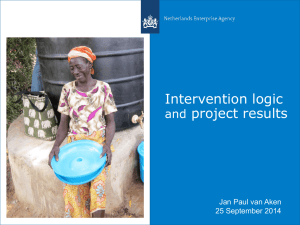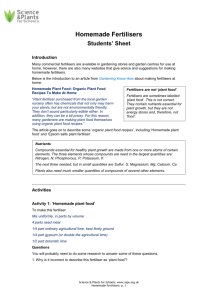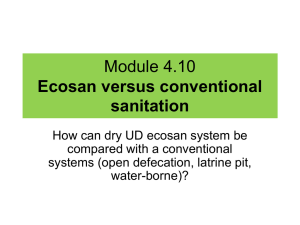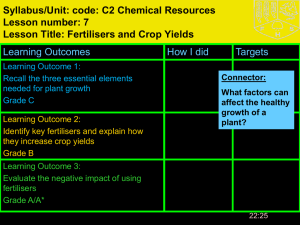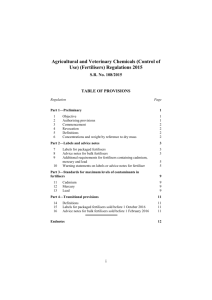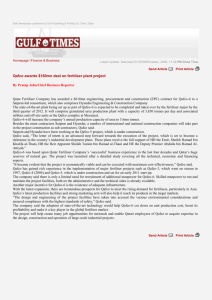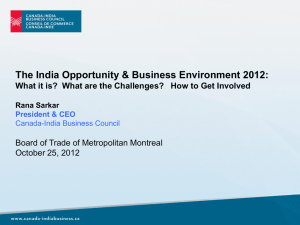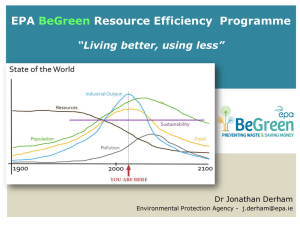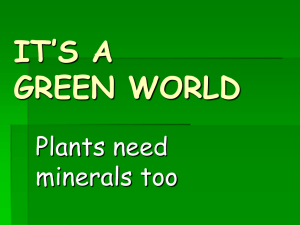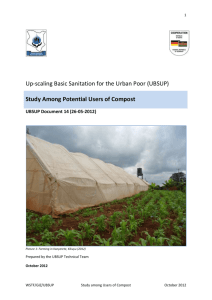Dr GERT v d Linde
advertisement
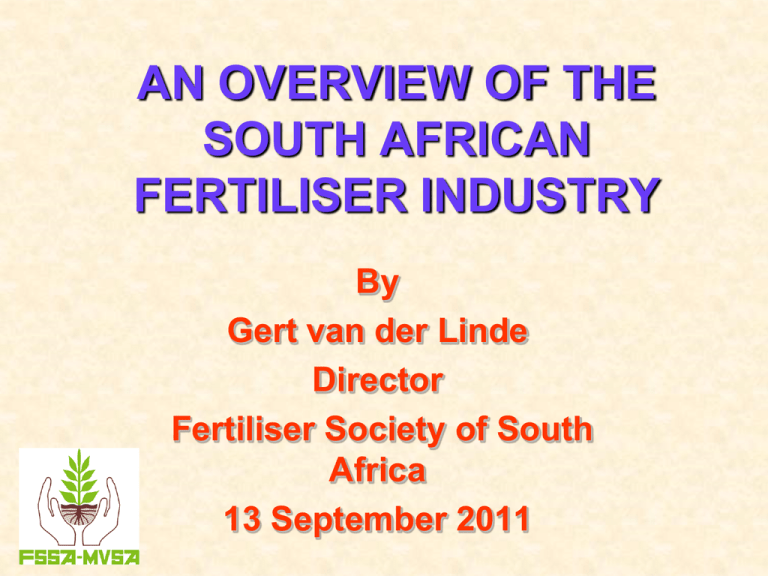
AN OVERVIEW OF THE SOUTH AFRICAN FERTILISER INDUSTRY By Gert van der Linde Director Fertiliser Society of South Africa 13 September 2011 Introduction • • • • • • • • Short historical overview Present Position Domestic Fertiliser Consumption Consumption by Crop Price Trends Local Industry matters Future outlook Fertiliser availability Introduction • South African Fertiliser Industry supplies about 2 million tons of fertiliser products annually. • This is equal to about 750 000 tons of plant nutrient (N + P2O5 + K2O) • At a value of around R10 billion ($1.4 billion) • Represents approximately 20% of RSA chemical industry (excluding oil) Short historical overview • First Chemical fertiliser used in 1890 • First local factory 1903 - Safco in Durban utilised bones for phosphate • 1919 - Kynoch started with explosives • 1921 - Cape Explosives started • Then several dry blending facilities were established Short historical overview • Price control was introduced in early 1940’s as a war measure. • Until early 80’s the industry flourished in a protected trade environment and under government support for agriculture in general Short historical overview • Development of SASOL, ISCOR, FOSKOR in early 1950’s • New companies started up such as:– Omnia – AECI – Triomf etc. Present Situation • In 1984 the opening up of the South African economy started • This led to liberalisation of trade policies and abolishment of price control. • It gained momentum during the 90’s • Led to large scale rationalisation and restructuring in the fertiliser industry Present Situation • During 2010 the last major restructuring of the SA fertiliser industry took place:• SASOL decided to concentrate on wholesale – closed their phos acid plant in Phalaborwa. • Yara decided to pull out of South Africa – sold their share of Sidi Pirani – sold their business to Farmsecure. Present Situation The South African fertiliser industry of today is fully exposed to world market forces in a totally deregulated environment with no import tariffs or government sponsored measures. Present Position Raw Material Producers 1. Nitrogen:- Sasol Limited supplies most of country’s ammonia some also from Arcellor Mittal (Iscor) 2. Phosphates:- Foskor supplies phosphate concentrate for domestic use and export. • Foskor is a significant exporter of phosphoric acid from Richards Bay Phosphoric acid production at Foskor, Richards Bay 700 000 600 000 400 000 300 000 200 000 2005 2004 2003 2002 2001 2000 1999 1998 1997 1996 1995 1994 1993 1992 1991 100 000 1990 Tonnes P2O5 500 000 Present Position 3. Potassium: - All South Africa’s potassium requirements are imported Present Position RSA fertiliser demand, domestic production & exports Nutrient Nitrogen (N) Demand Domestic (‘000 t) Production (‘000t) 400 250 Imports (‘000t) Products 150 Mostly Urea Phosphate (P2O5) 200 Over 90% of demand <10% of demand Mostly DAP Potassium (K2O) 160 None All Mostly MOP Present Position • Sasol Nitro, Profert and Omnia have granular and/or bulk blending plants. • They also produce liquid fertilisers • Several blender companies produce dry bulk blended products from these granular products as well as from imported raw materials. Domestic Fertiliser Consumption • 40% of total domestic fertiliser is consumed by Gauteng, Mpumalanga, Limpopo and North West province. • Free State uses 20% • Other 40% is consumed by Kwa ZuluNatal and the Western Cape. 3 500 000 700 000 3 000 000 600 000 2 500 000 500 000 2 000 000 400 000 1 500 000 300 000 1 000 000 200 000 500 000 100 000 Physical tons Nitrogen Phosphorous Potassium 2009 2006 2003 2000 1997 1994 1991 1988 1985 1982 1979 1976 1973 1970 1967 1964 1961 1958 0 1955 0 Nutrients (Tons) Fertiliser (Tons) Fertiliser consumption in South Africa 1955 to 2010 Fertiliser Use • The viability of the South African fertiliser industry is closely linked to the viability of the agricultural industry. • Maize production consumes ~40% of all fertiliser sold in SA. • Sugar cane 15% • Wheat 10% Fertiliser Consumption by Crop in SA Crops/groups Percent P2O5 K2O 175 25 8 <1 38 2 21 269 73 18 11 1 24 10 16 153 17 3 1 <1 54 4 3 82 265 46 20 2 116 16 40 505 41 7 3 <1 18 2 6 78 0.6 0.5 3 0.5 2 0.1 6 1 <1 <1 N Total Field crops Maize Wheat Sunflower Soybeans Sugar Cane Lucerne Other Pastures Sub Total Industrial crops Tobacco Cotton Price Trends • South Africa is a net importer of Potassium. • Imports around 50% of its Nitrogen requirements. • Domestic prices are severely impacted by international prices of raw materials and fertilisers as well as shipping costs and the Rand/$ exchange rate and the oil price. 400 1 200 350 1 000 300 800 250 600 200 400 150 200 100 Ammonia Sulphur Phosphoric acid Phosphate Rock Brent crude oil Apr-11 Dec-10 Aug-10 Apr-10 Dec-09 Aug-09 Apr-09 Dec-08 Aug-08 Apr-08 Dec-07 Aug-07 Apr-07 Dec-06 Aug-06 Apr-06 Dec-05 Aug-05 Apr-05 50 Dec-04 0 Oil Index 1 400 Aug-04 Index International Price Index of Raw Materials (Aug 2004 = 100) Urea Potassium DAP Brent crude oil Apr-11 Dec-10 Aug-10 Apr-10 Dec-09 Aug-09 Apr-09 Dec-08 Aug-08 Apr-08 Dec-07 Aug-07 Apr-07 Dec-06 Aug-06 Apr-06 Dec-05 Aug-05 Apr-05 Dec-04 Aug-04 Index 700 400 600 350 500 300 400 250 300 200 200 150 100 100 0 50 Oil Index International Price Index of Fertilisers (Aug 2004 = 100) 05/04/2011 05/10/2010 05/04/2010 05/10/2009 05/04/2009 05/10/2008 05/04/2008 05/10/2007 05/04/2007 05/10/2006 05/04/2006 05/10/2005 05/04/2005 05/10/2004 $/Barrel Brent Crude Oil Price History $145 $135 $125 $115 $105 $95 $85 $75 $65 $55 $45 $35 93 unleaded Diesel Jan-11 Jul-10 Jan-10 Jul-09 Jan-09 Jul-08 Jan-08 Jul-07 Jan-07 Jul-06 Jan-06 Jul-05 Jan-05 Jul-04 Jan-04 Jul-03 Jan-03 Jul-02 Jan-02 Jul-01 Jan-01 Rand/liter Price of fuel in Gauteng since Jan 2001 12.00 11.00 10.00 9.00 8.00 7.00 6.00 5.00 4.00 3.00 10/05/2011 10/01/2011 10/09/2010 10/05/2010 10/01/2010 10/09/2009 10/05/2009 10/01/2009 10/09/2008 10/05/2008 10/01/2008 10/09/2007 10/05/2007 10/01/2007 10/09/2006 10/05/2006 10/01/2006 10/09/2005 10/05/2005 Rand per $ Rand Dollar Exchange Rate 11.60 10.60 9.60 8.60 7.60 6.60 5.60 Government Control • All fertilisers, including organic, must be registered in terms of Act 36 of 1947. • The Act is administered by the National Department of Agriculture. • Quality and composition of fertilisers are monitored by the Registrar of Act 36. Government Control • The fertiliser industry is dependant on the Registrar to:• Help protect local industry by stopping illegal imports of unregistered products which do not conform to the regulations. • And to help maintain quality control of all products manufactured in SA. Future outlook • Looking back - Very little if any growth over last 10 Years • Looking forward - no significant growth expected in South Africa • Export opportunities into Africa should open up. Future outlook • Uncertainty around the land reform policy of the government - possible temporarily negative impact on fertilisation and crop planting - until emerging farmers are fully established as commercial farmers Future Outlook • More optimistically the emergence of a Bio-fuel industry may have positive impact on crop demand and thus fertiliser demand. Future Outlook Some further rationalisation may be required to maintain viability of the local fertiliser industry. Global Capacity Expansions and Investments (2005 – 2015) The Fertilizer Society of South Africa • FSSA was established in 1959 as a section 21 non-profit company. • Represents the fertiliser and aglime industries of SA. • Membership 18 in SA, 2 in Zimbabwe The Activities of the FSSA • Promotion of agro-economic and environmentally accountable fertilisation and liming practices. • Promotion of positive public awareness and acceptance of fertiliser use. • Act as a forum to facilitate effective liaison and negotiations with government, organised agriculture and other interest groups. The Fertiliser Advisor, Certification and Training Scheme (FACTS) of the FSSA FACTS • The FSSA and BASOS cc administer the FACT scheme. • The main objective is to enable people to have a basic understanding of fertilisers and agricultural lime and to enable them to advise growers and farmers in an economically and environmentally sound manner. FACTS • The training scheme is also of great benefit to farmers as they relate and interact much better with their appointed advisors. • It also provide extension officers with additional tools to help them to better ply their trade. • Since inception (1998) more than 600 candidates have enrolled and passed the written exam. FACTS consist of 8 Modules 1. Basic principles of plant nutrition 2. Factors that determine growth of plants 3. Origin, production and properties of fertilisers and aglimes 4. Advice and recommendations based on soil samples and yield potential 5. Application methods of fertilisers and aglime. 6. Transport, handling and storage of fertilisers. 7. Fertilisers and the environment. 8. Fertigation and irrigation Once enrolled, candidates are supplied with the FSSA’s flagship publication, “Fertiliser Handbook”. They also receive notes on the 8 modules. Each candidate that successfully passes the exam receives a credit card size certificate identifying him/her as an accredited fertiliser advisor. FACTS In countries outside South Africa the FACTS team will travel to the country and present the course over a period of one week to candidates. They will also facilitate the writing of the exams. www.fssa.org.za
